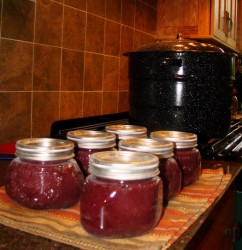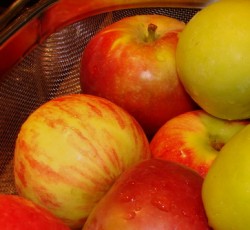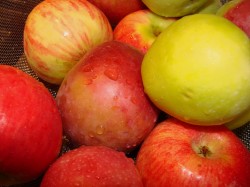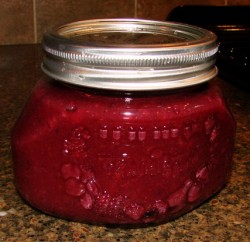Savoring the Fruits of the Season: Spiced Blueberry Applesauce
I love applesauce, but generally only when it is homemade.
When I was a kid, my Mom and both grandmothers ruined my ability to eat store-bought applesauce by making it from scratch from really good apples.
Compared to the somewhat chunky, thick, tart-sweet and cinnamon-laced concoctions they made the applesauce from the store tasted like insipid, grainy sugar-paste. All three of them insisted on good apples, and would buy from farmstands or farmers markets, and they never used the mealy, tasteless apples that the grocery stores carried.
Grandma and Grandpa didn’t have their own orchard on the farm, but they knew folks who did, and they would either buy bushels of fresh apples from them or trade some of their home-grown potatoes, cabbages, and some of Grandma’s canned tomatoes, beans and jellies for apples. They never got Red Delicious, either, an apple that Grandpa decried as a “worthless, tasteless excuse for an apple.” They always bought Cortlands, Jonathans, Grimes Golden, and Rome apples–all of them fairly tart, very firm and crisp, and delicious. They kept half of them in the root cellar in their bushel baskets to eat fresh or make pies from all winter. They stayed perfectly crisp that way, along with the potatoes, sweet potatoes, turnips, pumpkins and winter squash–and it took no electricity or anything to keep them cool and fresh. (Sometimes I think that when we modernized, we lost out on a lot of more sustainable ways of doing things–refrigerators and freezers are electricity hogs, for example.)
Here in Athens, we are blessed with several wonderful orchards, where many varieties of apples, pears, peaches, cherries, quinces, apricots, plums and other fruits are grown. Right now, the apples are madly in season–at least from the trees whose blossoms were not hit with the late frost in April. Because most of the arable land here in Athens county is in hillsides and valleys, which saved many of the apple blossoms from being destroyed by frost and snow–hills and valleys create microclimates with pockets of warm air that can protect a fruit tree from frost.
The apples I had on hand to make this applesauce were Cortland, MacIntosh, and Ginger Gold. Cortland are tart-sweet, and MacIntosh cook down to a wonderful thick, flowery-scented sauce, while the Ginger Golds are tart and zingy. I mixed them with some organic frozen blueberries, with the notion of feeding the sauce mainly to Kat, mixed into her morning oatmeal along with yogurt. Blueberries are one of her favorite fruits–and they are so full of nutrients, I cannot help but give them to her at every opportunity.
I only used one cup of sugar–much less than is usually stipulated for applesauce, and I used raw sugar, because I like the more complex flavor profile it gives to anything it is cooked with. It has similar flavor notes to honey, in my opinion, which is more interesting than white sugar which is just purely sweet. And then, because I cannot leave well enough alone, I added some spices: ginger, cardamom and allspice.
Cooking applesauce is easy–I just put the thinly sliced apples into a large pot with the blueberries, and added just enough water to barely cover the bottom. Then, I put the pot on the stove over high heat, and started cooking, stirring constantly, until the apples on the bottom let out their juices. Then, I stirred heartily in order to get the still raw apples and blueberries off the top of the pot and to the bottom, and stirred in the sugar and spices, and kept cooking until all of the apples and blueberries were soft and the MacIntosh apples had started to fall apart. I turned off the heat, and let the pot sit on the still warm stove in order to keep the sauce hot.
Then it was a simple matter of taking out my immersion blender and ground up the entire potful of fragrant fruit into a lovely, slightly chunky violet-hued puree. After that, I mixed in three tablespoons of bottled lemon juice to acidify the sauce in order to can it safely in a hot water bath canner. (In canning recipes, bottled lemon juice is specified over fresh because the bottled type has an exact pH which is known and thus the correct amount needed to acidify a recipe exactly can be ascertained.)
Then I packed it into hot jars, put on the lids and processed them in a boiling water bath for twenty minutes.
While it was processing, I took a taste of the applesauce, and shivered. It was that good–flowery and fruity, with the best qualities of both apples and blueberries, with a perfect balance between tart and sweet. The spices were subtle, but definitely present, and they took the sauce over the top into splendid. It will taste great in Kat’s oatmeal, for certain, but it is also something that I see the rest of us eating too. I can see putting it over good vanilla ice cream, or serving it with braised pork or roasted venison. Or using it as a tart filling or a spread on bread. Or just plain old eating it.
It is so good that I am buying more apples and blueberries tomorrow in order to make more of it in the coming week, in addition to a batch of plain spiced applesauce and a cherry applesauce.(Yes, I will post the recipes as I make them.)
Ingredients:
2 pounds frozen or fresh blueberries
5 pounds sliced cored apples {weigh them -after- peeling, coring and slicing and use several varieties for best flavor)
1 cup raw sugar or plain sugar
1 teaspoon ground ginger
1/2 teaspoon ground cardamom
1/4 teaspoon ground allspice
3 tablespoons bottled lemon juice
Method:
Place the apples and blueberries into a heavy bottomed pot large enough to hold all the ingredients and allow room for stirring. Add just enough water to cover the bottom of the pot–about 1/2 inch of water on the bottom or so.
Put the pot onto high heat and stirring constantly, bring to a boil. Turn heat down to medium, and stirring continually, cook until the apples are all soft and some are beginning to break down, thickening the released fruit juices. Stir in the sugar and spices and keep cooking until the sugar is well combined. Turn off the heat, but keep the pot on the stove in order to keep the applesauce hot.
Using an immersion blender, a food processor or food mill, grind the fruit up into a slightly chunky puree–or, if you wish, grind it down to a perfectly smooth puree.
Stir in the lemon juice thoroughly, then pack into hot pint or quart jars. Try to get any visible air bubbles out with a spatula; this is very difficult with very thick foods like applesauce, but try anyway. Wipe off the rim of the jar with a damp cloth, then center a lid on top and screw on a band. Do not tighten the band–just screw it down until it is closed, but not at all difficult to unscrew.
Put into a hot water bath canner, making certain that water covers the jars completely. Bring to a boil, clap the lids on top of the canner and process the jars for 20 minutes–the processing time is the same for either pints or quarts.
When they have processed for twenty minutes, turn off the heat and open the lid to the canner. Allow the jars to sit in the hot water for five minutes, then carefully lift up each jar and set it on a folded dishtowel in order to keep the counter from possibly cooling the glass too rapidly, causing the jar to crack.
Check the seals on the lids–they should be concave and very tightly adhered to the jar rim. If after 24 hours the lids have not sealed, either use up the food that did not seal, or re-pack using new jars and new lids.
Recipe makes eight pints or four quarts.
11 Comments
RSS feed for comments on this post.
Sorry, the comment form is closed at this time.
Powered by WordPress. Graphics by Zak Kramer.
Design update by Daniel Trout.
Entries and comments feeds.







I wonder..if you really wanted to use fresh lemon juice couldn’t you test the pH with those little test papers that we all used in science classes? I have some on hand from a cleanse I did and though pricey to invest in for something that you throw away, one pack has lasted me years.
Comment by starrrie — October 6, 2007 #
Starrie–I just ordered a pack of them! You and I thought exactly the same way!
I also got mine to test the acidity of my own homemade chili garlic paste (Chinese) before I can it.
Until I get the test strips, though, I will used the bottled juice, though I am loath to do so.
I guess we always have to remember that canning recipes are written for people who often wouldn’t have the knowledge of how to test pH. Or access to the equipment.
(If I keep canning stuff, I think I will probably invest in a pH meter.)
Comment by Barbara — October 6, 2007 #
[…] – Tigers & Strawberries is making Spiced Blueberry Applesauce […]
Pingback by The Wide World Of Food Preserving « The Apartment Farm — October 7, 2007 #
YUM! That apple-blueberry sauce sounds incredible. I’ve been processing apple compote from a half-bushel of McIntosh apples I bought at the farmers’ market this week. I’m freezing mine, but my freezer space is starting to get really crowded and I do have a canning setup. Maybe I’ll try some canning.
Comment by valereee — October 10, 2007 #
Is it a problem if after cooling the seal is good but there are some air bubbles on the sides of the jar?
Comment by Keri — October 22, 2007 #
Keri–if you were careful to get the bubbles out of the sides of the jar before you put the lid on and put it in the canner, you are fine.
The bubbles on the sides after the jar is processed comes from the fact that the fod item boils inside the jar. The air in the headspace of the jar is where those air bubbles come from–there is no worry. When you take the jars out of the canner, they are still bubbling on the inside–you can see it. When they cool off and stop bubbling some of the air is going to stay trapped below, just because the food cooled before the air could work its way to the top.
The reason you want to get trapped air bubbles out before you put the lid on is to make sure that the headspace of air at the top of the jar is not too great to make a good seal.
Th
Comment by Barbara — October 22, 2007 #
Awesome – I make applesauce every fall and freeze it in small containers for lunches – plus some in qt bags for suppers. This combo sounds great – I can’t wait to make it! Thanks for sharing.
Comment by Beth — April 16, 2008 #
I found an applesauce recipe a few years ago that I really like, but not only does yours incorporate blueberries, a tasty deviation from the norm, it sounds much healthier. I’m definitely going to try it this week, and I’m very excited :]
Comment by Brytt — August 4, 2008 #
So, somehow I still haven’t made this, but I’m just wondering- What exactly do I need for canning? I’ve never really canned anything and all this talk of pH and water baths is intimidating me a little.
Comment by Brytt — September 20, 2008 #
Hi. I made some blueberry applesauce last night. I used some Golden Delicious and Jonathan apples from a farm nearby and some frozen blueberries that my husband and I picked this summer. I usually just chop up apples and put them in a saucepan with a little water, cook til they’re soft, mash them up and run them through a foodmill to remove the seeds and skins. This time, I added the blueberries when the apples were almost soft and then ran everything through the foodmill. It turned out great! I used about 10 lb of whole apples and 2 lb of blueberries (with 1 c sugar) and ended up with 5.5 quarts of lovely purple sauce. Thanks for the great recipe!
Comment by Libby — October 25, 2009 #
That is Amazing! Thanks a ton.
Comment by Brandan — October 12, 2011 #